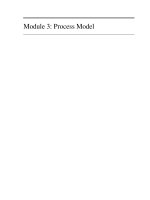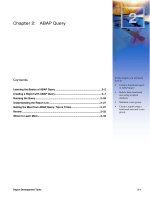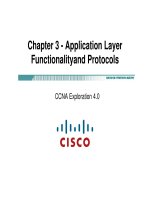Tài liệu Chapter 3 Data Transmission pdf
Bạn đang xem bản rút gọn của tài liệu. Xem và tải ngay bản đầy đủ của tài liệu tại đây (221.21 KB, 33 trang )
William Stallings
Data and Computer
Communications
Chapter 3
Data Transmission
Terminology (1)
Transmitter
Receiver
Medium
Guided medium
e.g. twisted pair, optical fiber
Unguided medium
e.g. air, water, vacuum
Terminology (2)
Direct link
No intermediate devices
Point-to-point
Direct link
Only 2 devices share link
Multi-point
More than two devices share the link
Terminology (3)
Simplex
One direction
e.g. Television
Half duplex
Either direction, but only one way at a time
e.g. police radio
Full duplex
Both directions at the same time
e.g. telephone
Frequency, Spectrum and
Bandwidth
Time domain concepts
Continuous signal
Various in a smooth way over time
Discrete signal
Maintains a constant level then changes to another constant
level
Periodic signal
Pattern repeated over time
Aperiodic signal
Pattern not repeated over time
Continuous & Discrete Signals
Periodic
Signals
Sine Wave
Peak Amplitude (A)
maximum strength of signal
volts
Frequency (f)
Rate of change of signal
Hertz (Hz) or cycles per second
Period = time for one repetition (T)
T = 1/f
Phase (φ)
Relative position in time
Varying Sine Waves
Wavelength
Distance occupied by one cycle
Distance between two points of corresponding
phase in two consecutive cycles
λ
Assuming signal velocity
v
λ = vT
λf = v
c = 3*10
8
ms
-1
(speed of light in free space)
Frequency Domain Concepts
Signal usually made up of many frequencies
Components are sine waves
Can be shown (Fourier analysis) that any signal
is made up of component sine waves
Can plot frequency domain functions
Addition of
Frequency
Components
Frequency
Domain
Spectrum & Bandwidth
Spectrum
range of frequencies contained in signal
Absolute bandwidth
width of spectrum
Effective bandwidth
Often just
bandwidth
Narrow band of frequencies containing most of the
energy
DC Component
Component of zero frequency
Signal with DC Component
Data Rate and Bandwidth
Any transmission system has a limited band of
frequencies
This limits the data rate that can be carried
Analog and Digital Data
Transmission
Data
Entities that convey meaning
Signals
Electric or electromagnetic representations of data
Transmission
Communication of data by propagation and
processing of signals
Data
Analog
Continuous values within some interval
e.g. sound, video
Digital
Discrete values
e.g. text, integers
Acoustic Spectrum (Analog)
Signals
Means by which data are propagated
Analog
Continuously variable
Various media
wire, fiber optic, space
Speech bandwidth 100Hz to 7kHz
Telephone bandwidth 300Hz to 3400Hz
Video bandwidth 4MHz
Digital
Use two DC components
Data and Signals
Usually use digital signals for digital data and
analog signals for analog data
Can use analog signal to carry digital data
Modem
Can use digital signal to carry analog data
Compact Disc audio
Analog Signals Carrying Analog
and Digital Data
Digital Signals Carrying Analog
and Digital Data
Analog Transmission
Analog signal transmitted without regard to
content
May be analog or digital data
Attenuated over distance
Use amplifiers to boost signal
Also amplifies noise
Digital Transmission
Concerned with content
Integrity endangered by noise, attenuation etc.
Repeaters used
Repeater receives signal
Extracts bit pattern
Retransmits
Attenuation is overcome
Noise is not amplified









